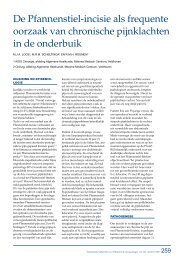Surgical management of chronic inguinal pain syndromes - Liespijn
Surgical management of chronic inguinal pain syndromes - Liespijn
Surgical management of chronic inguinal pain syndromes - Liespijn
Create successful ePaper yourself
Turn your PDF publications into a flip-book with our unique Google optimized e-Paper software.
INTRODUCTIONHernia recurrence rates have plummeted ever since the introduction <strong>of</strong> mesh. Researchinterest has, therefore, shifted towards studying the characteristics <strong>of</strong> <strong>chronic</strong> <strong>pain</strong> followingroutine implantation <strong>of</strong> mesh 1 . Approximately 11% <strong>of</strong> all operated hernia patientsare troubled by <strong>chronic</strong> <strong>inguinal</strong> <strong>pain</strong> 2-4 . About half suffers from neuropathic <strong>pain</strong>caused by entrapment or damage to one (or more) <strong>of</strong> the <strong>inguinal</strong> nerves (ilio<strong>inguinal</strong>,iliohypogastric or/ and genital branch <strong>of</strong> the genit<strong>of</strong>emoral nerve). The other halfexperience nociceptive <strong>pain</strong> including periostitis, recurrent hernia, folded mesh(‘meshoma’), fibrotic tissue or funiculodynia 5 .Published studies on treatment regimes for postherniorrhaphy <strong>inguinal</strong> <strong>pain</strong> <strong>syndromes</strong>are scarce. Examples <strong>of</strong> non-operative treatment options include nerve blocks with localanaesthetics and corticosteroids 6 , transcutaneous electric nerve stimulation (TENS), orpulsed radio frequency (PRF) 7 . Neuropathic <strong>pain</strong> caused by nerve entrapment can alsobe treated by an open nerve removal (neurectomy), as this technique effectivelydecreased <strong>pain</strong> in 60-80% <strong>of</strong> the patients 8-13 . Peripheral nerve blocks likely aid in discriminatingbetween <strong>pain</strong> types. However, it is important to realize that to our knowledgeno validation studies on sensitivity and specificity <strong>of</strong> nerve blocks in discriminatingneuropathic from nociceptive <strong>pain</strong> have been conducted.In order to evaluate which therapeutic regime serves best for neuropathic postherniorrhaphy<strong>pain</strong> <strong>syndromes</strong>, a randomized controlled trial was constructed comparingtwo frequently used treatment modalities, nerve blocks and neurectomy <strong>of</strong> the <strong>inguinal</strong>nerves. Characteristics <strong>of</strong> this randomized controlled trial will be discussed in thepresent article.METHODSStudy designThe GroinPain Trial is a randomized, non-blinded, monocenter study. The protocol wasapproved by the Regional Ethics Committee <strong>of</strong> the Máxima Medical Center, Veldhoven,The Netherlands (no. 0543). The objective is to evaluate long-term <strong>pain</strong> reduction inpatients with <strong>chronic</strong> postherniorrhaphy groin neuralgia following two different treatmentmodalities. Clinical results <strong>of</strong> nerve blocks with lidocain, corticosteroids and hyaluronicacid are compared with a operative neurectomy <strong>of</strong> the ilio<strong>inguinal</strong>, iliohypogastricor/and genital branch <strong>of</strong> the genit<strong>of</strong>emoral nerve(s). Patient enrolment started inFebruary 2006. The study protocol has been registered at www.clinicaltrial.gov(ClinicalTrials.gov identifier: NCT00306839).Study populationAll adult patients (18 years or older) with <strong>chronic</strong> neuropathic <strong>pain</strong> after routine <strong>inguinal</strong>hernia repair (open or laparoscopic) are considered for inclusion. A <strong>pain</strong>-free interval(hours to days/weeks) after a diagnostic nerve block using 10 cc 1% lidocain injectedinto the trigger point is a prerequisite for inclusion. Patients with less than 50% <strong>pain</strong>reduction do not qualify for study. A nerve block administered at the outpatientdepartment is part <strong>of</strong> our standard diagnostic pathway. In some patients, a diagnosticnerve blocks results in a persistent <strong>pain</strong> reduction. These patients are excluded fromfurther participation but are registered and monitored over time. To assure that theinternational definition for the study <strong>of</strong> <strong>chronic</strong> <strong>pain</strong> (<strong>pain</strong> persisting beyond the normalhealing period <strong>of</strong> 3 months) was applicable to all patients, the minimal follow-up period<strong>of</strong> three months was chosen. Patients were excluded if an adequate follow-up wasimpossible, omitting all patients with severely compromised physical or mental health.Patients with a recurrent <strong>inguinal</strong> hernia, harbouring signs <strong>of</strong> local inflammation or havingan American Society <strong>of</strong> Anaesthesiologists classification 3 or more are also excluded.RandomizationAfter a thorough explanation regarding rationale and important characteristics <strong>of</strong> thetrial, verbal and written informed consent is obtained at the outpatient department.Patients are subsequently randomized to repetitive nerve blocks using lidocain, corticosteroidsand hyaluronic acid (group A) or a neurectomy (group B, figure 1). Blocks <strong>of</strong>eight-randomization principle without prestratification are applied by computer.InterventionsNerve blocks (Group A, figure 2): This group receives an injection with 2 cc 1% Lidocain, 40mg corticosteroids (Depomedrol®), and 75 IE hyaluronic acid (Hyason®) at the surgicaloutpatient department. These blocks are placed in the <strong>pain</strong> trigger point. In case <strong>of</strong>additional genital branch neuralgia, a separate nerve block placed at the internal <strong>inguinal</strong>ring is <strong>of</strong>ten mandatory. If <strong>pain</strong> reduction is temporary, injections are repeated at twoweek intervals. A maximal number <strong>of</strong> three blocks is used over a six week period. Allinjections are administered by the principal investigators (M.L. or T.V.).Neurectomy (Group B): Patients are <strong>of</strong>fered surgery using spinal or general anaesthesiain a day-care setting. All operations are performed by the senior authors M.S. and R.R.,both experienced in performing this procedure. Patients receive 2.500 IU <strong>of</strong> low molecularheparin (Fragmin®) subcutaneously two hours prior to the procedure. By extendingthe <strong>inguinal</strong> incision some centimetres laterally, access is gained to an unaffected areain most cases. The iliohypogastric and/or ilio<strong>inguinal</strong> nerves penetrating internal obliquemuscles are identified and followed as proximal as possible. The prosthetic material isusually opened and dissected for additional exposure. If indicated, the genital branch98 Chapter 7Randomized controlled trial <strong>of</strong> neurectomy versus injection with lidocain, corticosteroids... 99





